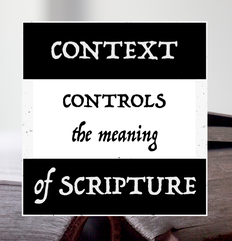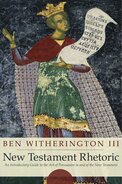
A 2-book set (or easy-to-search digital books on your Logos Bible App) organized by chapter and verse so you can quickly find relevant historical information that affects how you interpret the language in a verse. The content is limited in both the depth of background information and number of verses with commentary, but its usable design and easy introductions to the most relevant data make it the #1 tool for your Bible study toolbox. It will change the way you interpret the “hot or cold, not lukewarm” warning to Laodicea in Revelation 3:14-16.
NOTE: Click the article links at the end of each book description to read how historical background data in that book redefine the meaning of the Bible verses.
The old testament had to define its theology through contrast in comparison to the beliefs of other ancient near Eastern people. This scholarly yet comprehensible survey stops along the way to show you how the context read defines the meaning many misunderstood Old Testament passages. It will change the way you read the Creation epic in Genesis 1.
3. New Testament and the People of God - NT Wright
To interpret the New Testament, you need to understand the teaching, movements, and expectations of Second Temple Judaism that took shape from the time Jews returned from exile under Persia to Jesus‘s arrival under Roman Rule. NT Wright reframes the world that gave meaning to Jesus’ movement and ultimately the early church as he defines how people were painting the picture of what God would do next using the Hebrew prophets. His exegesis of Daniel 7 will reverse how you read Jesus’ apocalyptic claims about the direction of the Son of Man coming on the clouds in great glory (Matt 24:30).

Greco-Roman writers have a way of making points that we pass by until we understand the rhetorical techniques they employed to do so. We will continue to arbitrarily interpret many of Paul’s letters until we understand how each section works together to accomplish the purpose of the entire book. The central message of Romans and Galatians becomes clear when you learn from Ben Witherington how to identify the Propositioin Paul’s Argumentatio. Learning how to interpret an inclusiowill quickly correct the mistake that Romans 8:28 (“All things work together for good”) teaches God will make our problems go away.
5. The Dead Sea Scrolls and the Bible - James Vanderkam
This thorough and balanced introduction to the Dead Sea scrolls replaces the murky myth of what you might think was found in Qumran with a clear exposition of how the scrolls tell us what scriptures people respected in Jesus‘ day and how those scriptures shaped their expectations for what God would do next in history. The Scrolls’ portrait of the Jewish controversies in Jesus‘s day and the messianic expectations of the time will bring new life to many stories you read in the Gospels. You will discover where Jesus taught and practiced the same convictions of the separatist community in Qumran and where Jesus’ movement pushed an even more radical solution. The scrolls echo Jesus’ prophetic announcement of judgment on the rich and combine OT prophecies in ways that explain why Jews expected the Messiah to identify himself through miracles and resurrection.
6. Backgrounds of Early Christianity - Everett Ferguson
Greco-Roman and Jewish practices and ideas defined the expressions and issues addressed in the New Testament. This introduction takes you on an extensive exploration of the local and empire-wide dynamics that determined the conversation of the early church. Greco-Roman sections about religion will reveal how Dionysius worship rituals give meaning to Jesus’ injunctive “eat my flesh and drink my blood” and reading Josephus’s description of Jewish revolutionaries will distinguish how Jesus’ kingdom does not need the political power Jewish Zealots fought for (John 18:36).

The reason we misunderstand the meaning of the Gospels or Hebrews or the book of Revelation is because we haven’t heard the other voices in Jewish discussions about God’s people, his Messiah, and the next great intervention of God in human history. Reading Nickelsburg’s collection of Jewish commentaries, interpretations of the Prophets, and apocalyptic visions of God’s climactic work among his people will help you hear the issues that the New Testament addresses. There were no 400 years of silence between the Testaments, but rather dynamic discussions captured in numerous documents that rewrote the meaning of many Old Testament passages. Jewish apocalypses from Enoch to 4 Ezra will change your temporal framework for interpreting Revelation, the Halakic Letter from Qumran (4QMMT) will show you how Paul’s opponents advocated for “works of the Law,” and 4 Maccabees will bring to life Jewish substitutionary atonement theology prevalent in the Gospel of Mark. Reading Psalm of Solomon 17 will reveal why Jesus was not the Messiah his Jewish disciples expected.
8. On the Reliability of the Old Testament - Kenneth Kitchen
This Egyptologist and archaeologist will guide you through a long list of parallels between the Old Testament and Ancient Near Eastern artifacts. The parallels will reveal why God structured his Covenant with Israel the way he did and how Israel’s history fit into the larger narrative in the region. The linguistic, textual, and archaeological analysis will change how you read the early parts of the Old Testament and correct the mistaken belief that 2 to 3 million Israelites left Egypt during the Exodus (Exodus 12:37).
9. I Studied Inscriptions From Before The Flood - Richard Hess
If you want to know what’s special about the God of Genesis in the Bible, then you need to read about the crazy gods in other creation and flood narratives from the same environment. This book tells you which stories were important and lets you read them for yourself. You will stop reading the creation and flood narratives with your modern scientific questions in mind and start seeing the profound theological punchlines that would have hit an ancient Mesopotamian audience between the eyes. The Flood narrative is actually a new opportunity for Semitic people to meet a new God in a re-created world.
10. Paul Among the People - Sarah Ruden
Paul crafts long lists of sinful behavior that he condemns while telling believers that all things are lawful for them because they are free in Christ. So what exactly is the immoral behavior he hated and the freedom he promoted? This classical Greek scholar will take you deep into the dark side of the Greco-Roman world brought to life in theatrical and philosophical writings of the day so you can understand the underbelly of first-Century immorality that Paul condemned.
Multimedia: For those of you who don’t like to read (which seems unlikely since you read this top ten list), you can always watch a Bible Project video about any Bible book’s storyline in the context of Bible history before studying it. Or go watch my online Hermeneutics videos to learn how to study the Bible in its literary and historical context.
Software: If you own Logos Bible Study software (and have a big budget for buying books), then purchase Hallo & Younger's Context of Scripture to read ancient primary texts related to the Old Testament and Strack and Billerbeck’s Commentary on the New Testament from the Talmud and Midrash to learn how Jewish teaching, parables, and legal interpretations elucidates the meaning of New Testament passages. Rabbinic phrases and Bible interpretations will show you that Jesus’ yoke isn’t as easy as you think in Matthew 11:28-30 and Jesus healing people who touch his clothes was predicted in OT prophecy.






 RSS Feed
RSS Feed
